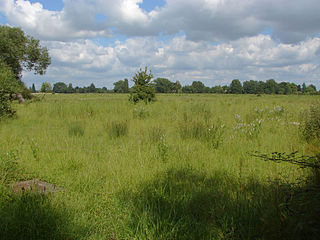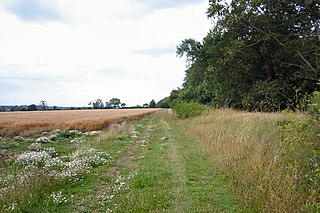| Newton Ketton Meadow | |
| Site of Special Scientific Interest | |
| Country | England |
|---|---|
| Region | North East |
| District | Darlington |
| Location | NZ322207 |
| - coordinates | 54°34′51″N1°30′9″W / 54.58083°N 1.50250°W Coordinates: 54°34′51″N1°30′9″W / 54.58083°N 1.50250°W |
| Area | 1.8 ha (4.4 acres) |
| Notification | 1989 |
| Management | Natural England |
| Area of Search | County Durham |
| Interest | Biological |
| Website: Map of site | |
Newton Ketton Meadow is a Site of Special Scientific Interest in the Darlington district of Durham, England. It is situated alongside a small tributary of the River Skerne, about 2 km south-west of the village of Great Stainton and 3 km east of the village of Brafferton.

A Site of Special Scientific Interest (SSSI) in Great Britain or an Area of Special Scientific Interest (ASSI) in the Isle of Man and Northern Ireland is a conservation designation denoting a protected area in the United Kingdom and Isle of Man. SSSI/ASSIs are the basic building block of site-based nature conservation legislation and most other legal nature/geological conservation designations in the United Kingdom are based upon them, including national nature reserves, Ramsar sites, Special Protection Areas, and Special Areas of Conservation. The acronym "SSSI" is often pronounced "triple-S I".

County Durham is a county in North East England. The county town is Durham, a cathedral city. The largest settlement is Darlington, closely followed by Hartlepool and Stockton-on-Tees. It borders Tyne and Wear to the north east, Northumberland to the north, Cumbria to the west and North Yorkshire to the south. The county's historic boundaries stretch between the rivers Tyne and Tees, thus including places such as Gateshead, Jarrow, South Shields and Sunderland.

England is a country that is part of the United Kingdom. It shares land borders with Wales to the west and Scotland to the north-northwest. The Irish Sea lies west of England and the Celtic Sea lies to the southwest. England is separated from continental Europe by the North Sea to the east and the English Channel to the south. The country covers five-eighths of the island of Great Britain, which lies in the North Atlantic, and includes over 100 smaller islands, such as the Isles of Scilly and the Isle of Wight.
The site is one of the few remaining traditional hay meadows on the coastal plain between the River Tees and the River Tyne and supports a rich variety of species characteristic of this habitat.

Hay is grass, legumes, or other herbaceous plants that have been cut and dried to be stored for use as animal fodder, particularly for large grazing animals raised as livestock, such as cattle, horses, goats, and sheep. However, it is also fed to smaller domesticated animals such as rabbits and guinea pigs. Even pigs may be fed hay, but they do not digest it as efficiently as herbivores.
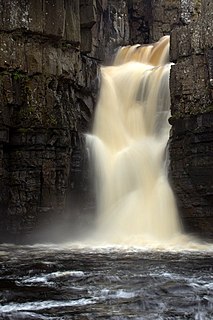
The River Tees is in northern England. It rises on the eastern slope of Cross Fell in the North Pennines, and flows eastwards for 85 miles (137 km) to reach the North Sea between Hartlepool and Redcar near Middlesbrough.
Great burnet, Sanguisorba officinalis , is present in abundance, as are herbs such as sneezewort, Achillea ptarmica , cuckooflower, Cardamine pratensis , meadowsweet, Filipendula ulmaria , and common spotted orchid, Dactylorhiza fuchsii . Grasses include sweet vernal-grass, Anthoxanthum odoratum , common bent, Agrostis capillaris , and downy oat-grass, Avenula pubescens . There are also a notable variety of sedges, including glaucous sedge, Carex flacca , hairy sedge, C. hirta , tawny sedge, C. hostiana , carnation sedge, C. panicea , and flea sedge, C. pulicaris . [1]
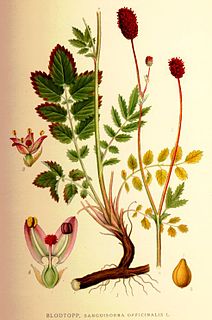
Sanguisorba officinalis, the great burnet, is a plant in the family Rosaceae, subfamily Rosoideae. It is native throughout the cooler regions of the Northern Hemisphere in Europe, northern Asia, and northern North America.
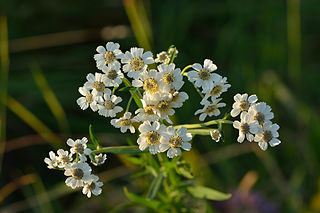
Achillea ptarmica, the sneezewort, sneezeweed, bastard pellitory, European pellitory, fair-maid-of-France, goose tongue, sneezewort yarrow, wild pellitory, or white tansy, is a European species of herbaceous perennial flowering plant in the genus Achillea. It is widespread across most of Europe and naturalized in scattered places in North America.

Cardamine pratensis, is a flowering plant in the family Brassicaceae, native throughout most of Europe and Western Asia. The specific name pratensis is Latin for "meadow."





